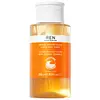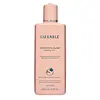What's inside
What's inside
 Key Ingredients
Key Ingredients

 Benefits
Benefits

 Concerns
Concerns

 Ingredients Side-by-side
Ingredients Side-by-side

Water
Skin ConditioningSodium Lactate
BufferingLactic Acid
BufferingHeptyl Glucoside
Potassium Azeloyl Diglycinate
Skin ConditioningTriethyl Citrate
MaskingGlyceryl Caprylate
EmollientSalix Nigra Bark Extract
Skin ProtectingBenzoic Acid
MaskingCitrus Nobilis Peel Oil
MaskingCitrus Aurantium Dulcis Flower Oil
AstringentCitrus Grandis Peel Oil
MaskingCitrus Tangerina Peel Oil
MaskingHeptanol
PerfumingParfum
MaskingLimonene
PerfumingWater, Sodium Lactate, Lactic Acid, Heptyl Glucoside, Potassium Azeloyl Diglycinate, Triethyl Citrate, Glyceryl Caprylate, Salix Nigra Bark Extract, Benzoic Acid, Citrus Nobilis Peel Oil, Citrus Aurantium Dulcis Flower Oil, Citrus Grandis Peel Oil, Citrus Tangerina Peel Oil, Heptanol, Parfum, Limonene
Water
Skin ConditioningGlycerin
HumectantHydrolyzed Opuntia Ficus-Indica Flower Extract
AbrasiveHippophae Rhamnoides Fruit Juice
Skin ConditioningLaminaria Digitata Extract
Skin ProtectingMalpighia Glabra Fruit Juice
Skin ConditioningPhenoxyethanol
PreservativePolysorbate 20
EmulsifyingSaccharide Isomerate
HumectantSodium Gluconate
Skin ConditioningParfum
MaskingBenzoic Acid
MaskingDehydroacetic Acid
PreservativeLimonene
PerfumingSodium Hydroxide
BufferingLinalool
PerfumingEthylhexylglycerin
Skin ConditioningGeraniol
PerfumingSodium Benzoate
MaskingCitral
PerfumingPotassium Sorbate
PreservativeCitronellol
PerfumingCitric Acid
BufferingSodium Citrate
BufferingWater, Glycerin, Hydrolyzed Opuntia Ficus-Indica Flower Extract, Hippophae Rhamnoides Fruit Juice, Laminaria Digitata Extract, Malpighia Glabra Fruit Juice, Phenoxyethanol, Polysorbate 20, Saccharide Isomerate, Sodium Gluconate, Parfum, Benzoic Acid, Dehydroacetic Acid, Limonene, Sodium Hydroxide, Linalool, Ethylhexylglycerin, Geraniol, Sodium Benzoate, Citral, Potassium Sorbate, Citronellol, Citric Acid, Sodium Citrate
 Reviews
Reviews

Alternatives
Ingredients Explained
These ingredients are found in both products.
Ingredients higher up in an ingredient list are typically present in a larger amount.
Benzoic Acid is used to preserve and adjust the pH of products.
The antimicrobial property of Benzoic Acid helps elongate a product's shelf life. Its main role is to reduce fungi growth and is not found to be effective at fighting bacteria. Therefore Benzoic Acid is always added along with other preservatives.
In its pure form, Benzoic Acid looks like a white crystalline solid. It has slight solubility in water.
The name of Benzoic Acid comes from gum benzoin, which used to be the sole source of deriving this ingredient. Benzoic Acid is the most simple aromatic carboxylic acid.
Benzoic Acid is naturally occuring in strawberries, mustard, cinnamon, and cloves. It has a slight scent but is not considered to be a fragrance.
Learn more about Benzoic AcidLimonene is a fragrance that adds scent and taste to a formulation.
It's found in the peel oil of citrus fruits and other plants such as lavender and eucalyptus. The scent of limonene is generally described as "sweet citrus".
Limonene acts as an antioxidant, meaning it helps neutralize free radicals.
When exposed to air, oxidized limonene may sensitize the skin. Because of this, limonene is often avoided by people with sensitive skin.
The term 'fragrance' is not regulated in many countries. In many cases, it is up to the brand to define this term. For instance, many brands choose to label themselves as "fragrance-free" because they are not using synthetic fragrances. However, their products may still contain ingredients such as essential oils that are considered a fragrance.
Learn more about LimoneneParfum is a catch-all term for an ingredient or more that is used to give a scent to products.
Also called "fragrance", this ingredient can be a blend of hundreds of chemicals or plant oils. This means every product with "fragrance" or "parfum" in the ingredients list is a different mixture.
For instance, Habanolide is a proprietary trade name for a specific aroma chemical. When used as a fragrance ingredient in cosmetics, most aroma chemicals fall under the broad labeling category of “FRAGRANCE” or “PARFUM” according to EU and US regulations.
The term 'parfum' or 'fragrance' is not regulated in many countries. In many cases, it is up to the brand to define this term.
For instance, many brands choose to label themselves as "fragrance-free" because they are not using synthetic fragrances. However, their products may still contain ingredients such as essential oils that are considered a fragrance by INCI standards.
One example is Calendula flower extract. Calendula is an essential oil that still imparts a scent or 'fragrance'.
Depending on the blend, the ingredients in the mixture can cause allergies and sensitivities on the skin. Some ingredients that are known EU allergens include linalool and citronellol.
Parfum can also be used to mask or cover an unpleasant scent.
The bottom line is: not all fragrances/parfum/ingredients are created equally. If you are worried about fragrances, we recommend taking a closer look at an ingredient. And of course, we always recommend speaking with a professional.
Learn more about ParfumWater. It's the most common cosmetic ingredient of all. You'll usually see it at the top of ingredient lists, meaning that it makes up the largest part of the product.
So why is it so popular? Water most often acts as a solvent - this means that it helps dissolve other ingredients into the formulation.
You'll also recognize water as that liquid we all need to stay alive. If you see this, drink a glass of water. Stay hydrated!
Learn more about Water